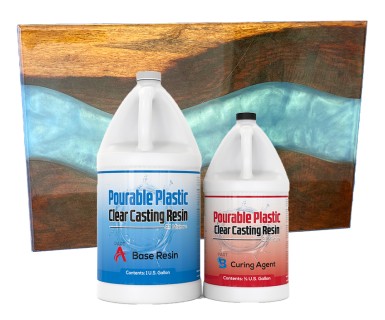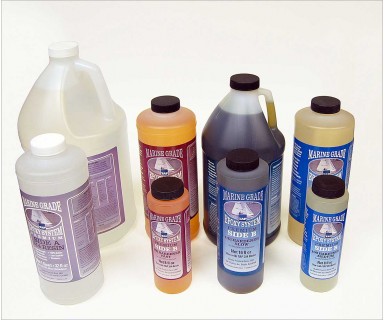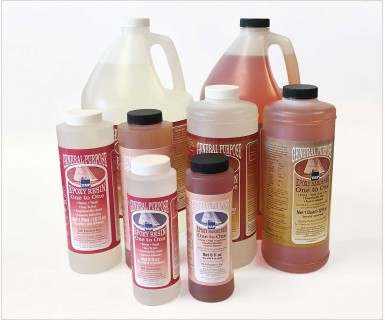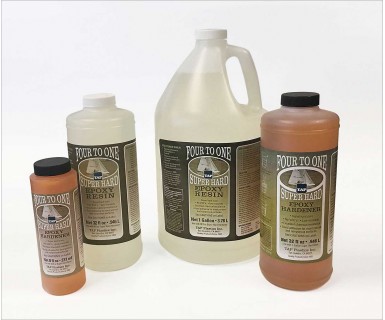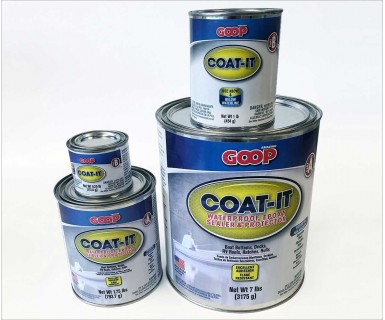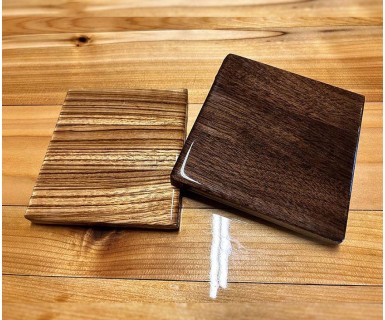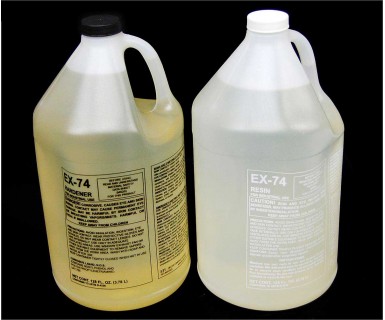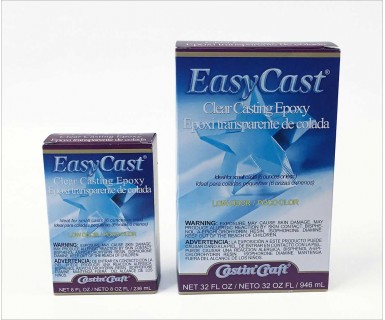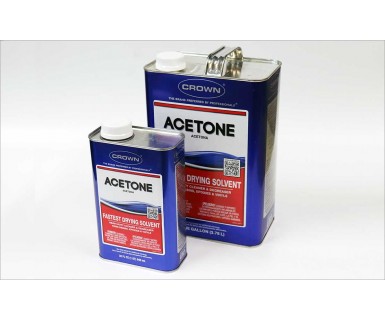Epoxy Resins
When working with materials like fiberglass, carbon fiber, wood, and metal, a strong bond is essential. Epoxy resin stands out for its superior adhesion, minimal shrinkage, and excellent resistance to chemicals and water. Unlike other adhesives, epoxy resins have a low odor and low VOCs, making them safer for your health and the environment.
TAP Plastics offers a wide selection of epoxy resins tailored to various applications, from laminating composites to performing intricate repair work. Whether you're tackling a DIY project or a professional task, you'll find the perfect epoxy resin to meet your needs. Find our collection of fiberglass fabrics here.
Epoxy Resin Information
What is an Epoxy Resin and What is it Used For?
Epoxy resin is renowned for its incredible adhesion strength and durability. It is a versatile, very strong polymer used for its high performance in a variety of applications. Two-part epoxy, or an epoxy resin kit, contains a resin and separate curing agent that, when mixed, catalyze into a solid form that cures at normal temperatures. The type of curing agent, or hardener, used with the resin gives it a broad range of characteristics such as curing temperature and time, viscosity, color, durability, and adhesive qualities. Whether you're working on a fiberglass project, a table top epoxy project, crafting something unique or creating a beautiful floor or countertop, our epoxy resin will help you achieve the results you desire.
What Should I Consider When Buying Epoxy?
Every epoxy system is formulated for different characteristics including viscosity, curing and resistance temperatures, hardness, color and durability. With the wide range of materials it can be used with, including wood, fiberglass, metal, glass, stone, concrete, ceramics and marine environments, there may be multiple options to accomplish your goals.
Choosing the Right Epoxy Resin System for Your Project
| Application | Product | Properties |
|---|---|---|
| Live Edge and River Tables, Deep Pour | Pourable Plastic Deep Pour Epoxy | Super clear, pours up to 2" per application |
| Casting Molds for Arts, Crafts, and Jewelry | EasyCast Clear Casting Epoxy | Solid, clear |
| TAP Quik-Cast Polyurethane | Opaque | |
| Woodworking | TAP General Purpose Epoxy | Superior adhesion and flexibility |
| Boat Repair and Composite Making | TAP Marine Grade Epoxy System | High strength adhesive, water-proof, cures at low temperatures, high and low viscosity options |
| Industrial, Multi-Purpose, General Hard Coatings | TAP Super-Hard Epoxy | Durable, hard coating with excellent chemical resistance |
| Coat-It Epoxy Sealer with Kevlar® | Use above or below the waterline | |
| EX-74 | High gloss UV-resistant surface, resists yellowing |
Tips & Helpful Tools for Applying Epoxy Resin
-
Determine how much you will need and only mix as much as can be applied before it starts to set in your container. It is better to mix smaller amounts for longer pot life.
-
Epoxy can be poured from a cup and spread evenly with plastic spreaders or with rollers, especially when using with fiberglass.
-
Wear disposable gloves and change often to avoid getting sticky residue on your hands and tools.
-
Use resin hand pumps to carefully and neatly dispense just the amount needed.
-
Plastic or disposable measuring cups make it easy to get proper mix ratios.
-
Add a power drill mixer for either pint-size or gallon sized containers for the most efficient and best mixing of resin and hardener. It is critical to thoroughly mix the resin system together.
-
When working with overhead or wide-gap applications, use epoxy fillers to increase viscosity and reduce sag.
Epoxy Processing Time and Curing Time
The curing time of epoxy resin is the time it takes for the maximum hardness and durability to be reached after mixing the two parts. When used in conjunction with the correct curing time, epoxy can create a bond that is practically unbreakable. This makes epoxy resin the perfect choice for a variety of applications, from home repairs to major construction projects. With the right curing time, you can be sure your project will be completed quickly and efficiently.
Processing Time / Pot Life
The pot life is the period from when the epoxy and hardener is first mixed to when it begins to thicken to a point where it’s no longer possible to work with, also called processing time. Generally this is the time it takes for the mix to double in viscosity. Heat plays a critical role in pot life and curing time. A larger volume of epoxy system mixed at once will generate more heat as it begins to set, accelerating the reaction and decreasing pot life. For this reason it is better to mix smaller amounts for longer pot life. A faster processing time typically also means a faster curing time as well. Each epoxy system will have a specified working time based on ambient temperature and humidity.
How to Color Epoxy
We offer up to 12 colors of epoxy pigment powder designed to go with our Pourable Plastic Clear Casting Resin system. Note that we do not recommend using these pigments with our other epoxies that have an amber or honey-colored tint.
Types of Epoxy Resin
General-purpose epoxy is commonly used with fiberglass for repairs on metal and wood structures, such as livestock trailers, boat hulls, passenger cars, and so much more. With a relatively fast curing rate, you can significantly improve assembly time and costs overall.
Super-hard epoxy resins provide superior surface hardness and excellent chemical resistance, making them useful for repairing fume hoods, ducts, floors, and other areas that are prone to acid, corrosion, or gasoline.
Marine-grade epoxies are formulated to resist saltwater and other hazards of the sea. They are some of the safest adhesives available.
Other types include waterproof epoxies, polymer coatings, multipurpose sealants, and glass-like coatings with UV inhibitors to reduce yellowing of epoxies.
Epoxy Cleanup and Solvents
Always follow the product instructions when using solvents and avoid skin contact. Most of these solvent products are highly flammable once applied to rags so be sure to dispose of properly before placing in garbage!
Cleaning Up Epoxy Resin
Since epoxy resin is not water soluble, solvents such as acetone, lacquer thinner, or denatured alcohol should be used. High percentage vinegar or isopropyl alcohol may also work.
Cleaning Up Epoxy Hardener
The hardener, sometimes called the curing agent or B-side, is easier to clean up but is also more hazardous. Be sure to wear gloves and avoid getting the hardener on your skin. Hot, soapy water is often effective for cleaning uncured hardener. Gentler solvents such as vinegar or isopropyl alcohol can work, as well as acetone, lacquer thinner, or denatured alcohol.
Cleaning Up Mixed Epoxy Resin and Hardener
Mixed epoxy will eventually cure. To clean it before curing, use gloves and clean with acetone, lacquer thinner, or denatured alcohol, following product safety instructions.
Epoxy Resins FAQ
Q1: How do I properly mix fiberglass epoxy resin and hardener?
A1: Properly mixing fiberglass epoxy resin and hardener is crucial for achieving optimal results. Begin by measuring the resin and hardener according to the ratio in the manufacturer's instructions, usually specified on the packaging. Thoroughly mix the two components in a clean container for the specified time, ensuring no streaks or inconsistencies remain. Following the correct mixing process will ensure the resin cures effectively and attains its desired properties.
Q2: What safety precautions should I take when working with fiberglass epoxy resins?
A2: Working with fiberglass epoxy resins involves certain safety considerations. Always wear appropriate personal protective equipment (PPE) such as gloves, safety glasses, and a respirator to avoid direct skin contact and inhalation of fumes. Ensure you work in a well-ventilated area or use a respirator with appropriate filters. Read and follow the manufacturer's safety guidelines provided on the product's packaging or label.
